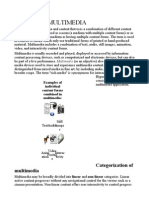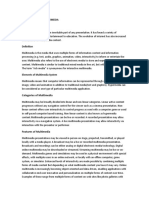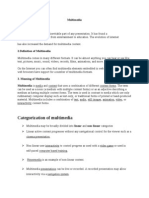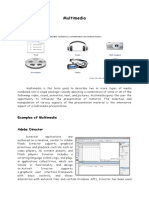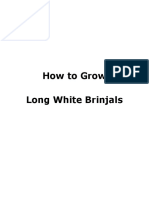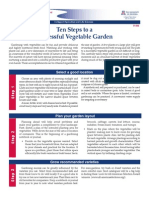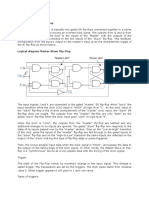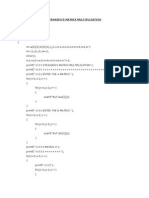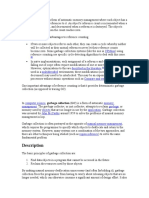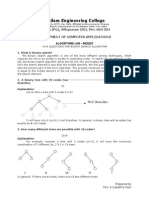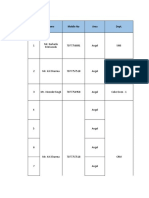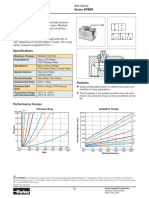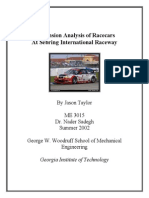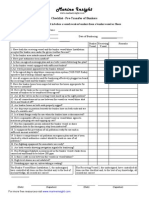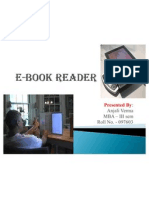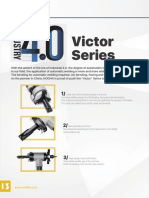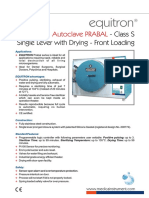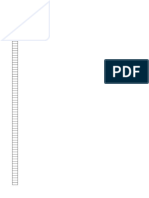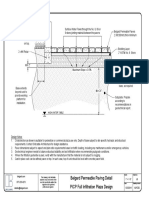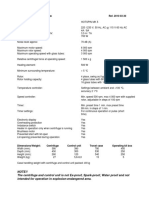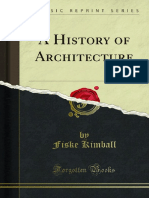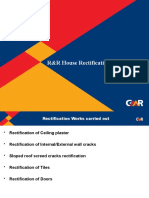0 ratings0% found this document useful (0 votes)
211 views25 pagesMultimedia Database Organization
Multimedia refers to media and content that uses a combination of different content forms such as text, audio, still images, animation, video, and interactivity. It is usually accessed through electronic devices like computers. Multimedia content can be linear, with no navigation control for the viewer, or non-linear, with user interactivity to control progress. Major characteristics of multimedia include various presentation and transmission formats, both live and recorded, as well as the ability to enhance the user experience through multiple forms of media.
Uploaded by
Subathra Devi MourouganeCopyright
© © All Rights Reserved
We take content rights seriously. If you suspect this is your content, claim it here.
Available Formats
Download as DOC, PDF, TXT or read online on Scribd
0 ratings0% found this document useful (0 votes)
211 views25 pagesMultimedia Database Organization
Multimedia refers to media and content that uses a combination of different content forms such as text, audio, still images, animation, video, and interactivity. It is usually accessed through electronic devices like computers. Multimedia content can be linear, with no navigation control for the viewer, or non-linear, with user interactivity to control progress. Major characteristics of multimedia include various presentation and transmission formats, both live and recorded, as well as the ability to enhance the user experience through multiple forms of media.
Uploaded by
Subathra Devi MourouganeCopyright
© © All Rights Reserved
We take content rights seriously. If you suspect this is your content, claim it here.
Available Formats
Download as DOC, PDF, TXT or read online on Scribd
You are on page 1/ 25
Organizing Multimedia Databases
Multimedia is media and content that utilizes a combination of different
content forms. The term can be used as a noun (a medium with multiple
content forms) or as an adjective describing a medium as having multiple
content forms. The term is used in contrast to media which only utilize
traditional forms of printed or hand-produced material. Multimedia includes
a combination of text audio still images animation video and interactivity
content forms.
Multimedia is usually recorded and played displayed or accessed by
information content processing devices such as computerized and electronic
devices but can also be part of a live performance. Multimedia (as an
adjective) also describes electronic media devices used to store and
experience multimedia content. Multimedia is similar to traditional mixed
media in fine art but with a broader scope. The term !rich media! is
synonymous for interactive multimedia. "ypermedia can be considered one
particular multimedia application.
Categorization of multimedia
Multimedia may be broadly divided into linear and non-linear categories.
#inear active content progresses without any navigation control for the
viewer such as a cinema presentation. $on-linear content offers user
interactivity to control progress as used with a computer game or used in
self-paced computer based training. "ypermedia is an example of non-linear
content.
Multimedia presentations can be live or recorded. % recorded presentation
may allow interactivity via a navigation system. % live multimedia
presentation may allow interactivity via an interaction with the presenter or
performer.
Major characteristics of multimedia
Multimedia presentations may be viewed in person on stage projected
transmitted or played locally with a media player. % broadcast may be a live
or recorded multimedia presentation. &roadcasts and recordings can be
either analog or digital electronic media technology. 'igital online
multimedia may be downloaded or streamed. (treaming multimedia may be
live or on-demand.
Multimedia games and simulations may be used in a physical environment
with special effects with multiple users in an online networ) or locally with
an offline computer game system or simulator.
The various formats of technological or digital multimedia may be intended
to enhance the users* experience for example to ma)e it easier and faster to
convey information. +r in entertainment or art to transcend everyday
experience.
% lasershow is a live multimedia performance.
,nhanced levels of interactivity are made possible by combining multiple
forms of media content. +nline multimedia is increasingly becoming object-
oriented and data-driven enabling applications with collaborative end-user
innovation and personalization on multiple forms of content over time.
,xamples of these range from multiple forms of content on -eb sites li)e
photo galleries with both images (pictures) and title (text) user-updated to
simulations whose co-efficients events illustrations animations or videos
are modifiable allowing the multimedia !experience! to be altered without
reprogramming. .n addition to seeing and hearing "aptic technology
enables virtual objects to be felt. ,merging technology involving illusions of
taste and smell may also enhance the multimedia experience.
Terminology
History of the term
.n /012 the term Multi-media was used to describe the Exploding Plastic
Inevitable a performance that combined live roc) music cinema
experimental lighting and performance art.
3citation needed4
.n the intervening forty years the word has ta)en on different meanings. .n
the late /056s the term was used to describe presentations consisting of
multi-projector slide shows timed to an audio trac).
3citation needed4
.n the /006s it
too) on its current meaning. .n common usage the term multimedia refers to
an electronically delivered combination of media including video still
images audio text in such a way that can be accessed interactively.
3/4
Much
of the content on the web today falls within this definition as understood by
millions.
(ome computers which were mar)eted in the /006s were called
!multimedia! computers because they incorporated a 7'-8+M drive which
allowed for the delivery of several hundred megabytes of video picture and
audio data.
Word usage and context
(ince media is the plural of medium the term !multimedia! is a pleonasm if
!multi! is used to describe multiple occurrences of only one form of media
such as a collection of audio 7's. This is why it*s important that the word
!multimedia! is used exclusively to describe multiple forms of media and
content.
The term !multimedia! is also ambiguous. (tatic content (such as a paper
boo)) may be considered multimedia if it contains both pictures and text or
may be considered interactive if the user interacts by turning pages at will.
&oo)s may also be considered non-linear if the pages are accessed non-
se9uentially. The term !video! if not used exclusively to describe motion
photography is ambiguous in multimedia terminology. Video is often used to
describe the file format delivery format or presentation format instead of
"footage" which is used to distinguish motion photography from
"animation" of rendered motion imagery. Multiple forms of information
content are often not considered multimedia if they don*t contain modern
forms of presentation such as audio or video. #i)ewise single forms of
information content with single methods of information processing (e.g.
non-interactive audio) are often called multimedia perhaps to distinguish
static media from active media. :erforming arts may also be considered
multimedia considering that performers and props are multiple forms of both
content and media.
sage
;host 8econ %dvanced -arfighter <. =ideo games may include a
combination of text audio still images animation video and interactivity
content forms.
% presentation using :owerpoint. 7orporate presentations may combine all
forms of media content.
=irtual reality uses multimedia content. %pplications and delivery platforms
of multimedia are virtually limitless.
!!O Multimedia-Terminal in Dresden WTC "#ermany$
Multimedia finds its application in various areas including but not limited
to advertisements art education entertainment engineering medicine
mathematics business scientific research and spatial temporal applications.
(everal examples are as follows>
Creati%e industries
Creati%e industries use multimedia for a variety of purposes ranging from
fine arts to entertainment to commercial art to journalism to
media and software services provided for any of the industries
listed below. %n individual multimedia designer may cover the
spectrum throughout their career. 8e9uest for their s)ills range
from technical to Commercial
Much of the electronic old and new media utilized by commercial artists is
multimedia. ,xciting presentations are used to grab and )eep attention in
advertising. &usiness to business and interoffice communications are often
developed by creative services firms for advanced multimedia presentations
beyond simple slide shows to sell ideas or liven-up training. 7ommercial
multimedia developers may be hired to design for governmental services and
nonprofit services applications as well.
&ntertainment and fine arts
.n addition multimedia is heavily used in the entertainment industry
especially to develop special effects in movies and animations. Multimedia
games are a popular pastime and are software programs available either as
7'-8+Ms or online. (ome video games also use multimedia features.
Multimedia applications that allow users to actively participate instead of
just sitting by as passive recipients of information are called Interactive
Multimedia. .n the %rts there are multimedia artists whose minds are able to
blend techni9ues using different media that in some way incorporates
interaction with the viewer. +ne of the most relevant could be :eter
;reenaway who is melding 7inema with +pera and all sorts of digital
media. %nother approach entails the creation of multimedia that can be
displayed in a traditional fine arts arena such as an art gallery. %lthough
multimedia display material may be volatile the survivability of the content
is as strong as any traditional media. 'igital recording material may be just
as durable and infinitely reproducible with perfect copies every time.
&ducation
.n ,ducation multimedia is used to produce computer-based training
courses (popularly called 7&Ts) and reference boo)s li)e encyclopedia and
almanacs. % 7&T lets the user go through a series of presentations text
about a particular topic and associated illustrations in various information
formats. ,dutainment is an informal term used to describe combining
education with entertainment especially multimedia entertainment.
#earning theory in the past decade has expanded dramatically because of the
introduction of multimedia. (everal lines of research have evolved (e.g.
7ognitive load Multimedia learning and the list goes on). The possibilities
for learning and instruction are nearly endless.
&ngineering
(oftware engineers may use multimedia in 7omputer (imulations for
anything from entertainment to training such as military or industrial
training. Multimedia for software interfaces are often done as a collaboration
between creative professionals and software engineers.
'ndustry
.n the .ndustrial sector multimedia is used as a way to help present
information to shareholders superiors and cowor)ers. Multimedia is also
helpful for providing employee training advertising and selling products all
over the world via virtually unlimited web-based technologies.
Mathematical and scientific research
.n mathematical and scientific research multimedia are mainly used for
modelling and simulation. ?or example a scientist can loo) at a molecular
model of a particular substance and manipulate it to arrive at a new
substance. 8epresentative research can be found in journals such as the
@ournal of Multimedia.
Medicine
.n Medicine doctors can get trained by loo)ing at a virtual surgery or they
can simulate how the human body is affected by diseases spread by viruses
and bacteria and then develop techni9ues to prevent it.
Miscellaneous
.n ,urope the reference organization for Multimedia industry is the
,uropean Multimedia %ssociations 7onvention (,MM%7).
%n observatory for jobs in the multimedia industry provides surveys and
analysis about multimedia and .T7 jobs.3/4
(tructuring information in a multimedia form
Multimedia represents the convergence of text pictures video and sound
into a single form. The power of multimedia and the .nternet lies in the way
in which information is lin)ed.
Multimedia and the .nternet re9uire a completely new approach to writing.
The style of writing that is appropriate for the *on-line world* is highly
optimized and designed to be able to be 9uic)ly scanned by readers.
3<4
% good site must be made with a specific purpose in mind and a site with
good interactivity and new technology can also be useful for attracting
visitors. The site must be attractive and innovative in its design function in
terms of its purpose easy to navigate fre9uently updated and fast to
download.
3A4
-hen users view a page they can only view one page at a time. %s a result
multimedia users must create a Bmental model of information structureC.
3D4
:atric) #ynch author of the Eale Fniversity -eb (tyle Manual states that
users need predictability and structure with clear functional and graphical
continuity between the various components and subsections of the
multimedia production. .n this way the home page of any multimedia
production should always be a landmar) able to be accessed from anywhere
within a multimedia piece
)pplication O%erflo*
Windo*s Wor+flo* ,oundation (-?) is a Microsoft technology for
defining executing and managing wor)flows. This technology was first
released in $ovember <661 as a part of .$,T ?ramewor) A.6.
-or)flows li)e traditional programs allow you to coordinate wor) but have
some important differences.
-or)flows can handle long running wor) by persisting to a durable
store such as a database when idle and loading again once there is
wor) to do
%n instance of a wor)flow can be modified dynamically while
running in the event that new conditions re9uire the wor)flow to
behave differently from the way it did when it was created
-or)flows are a declarative way of writing programs by lin)ing
together pre-defined activities rather than an imperative programming
model of writing lines of code
-or)flows allow you to declare business rules that are separated from
your code ma)ing it easier for you to modify them in the future
-or)flows support different styles of systems with se9uential and
state machine wor)flows
Microsoft has indicated that wor)flows are going to be a cornerstone of the
future (ervice +riented %rchitecture platform announced in +ctober <665
codename +slo
)uthoring Wor+flo*s
% new GM#-based language called G%M# is commonly used for declaring
the structure of a wor)flow. "owever the wor)flow may also be expressed
in code using any .$,T-targeted language (=&.$,T 7H 7IIJ7#. etc.).
-? provides .$,T developers with the ability to separate the logic of their
application from the underlying execution components thus providing a
clearer more manageable representation of the application. This approach
lends credence to the growing process-driven application methodology
which aims to separate an application*s logical flow from its executable
components at an enterprise level.
-or)flows comprise *activities*. 'evelopers can write their own domain-
specific activities and then use them in wor)flows. -? also provides a set of
general-purpose *activities* that cover several control flow constructs.
-indows -or)flow ?oundation is supported by a companion set of
extensions to =isual (tudio <662. These extensions contain a visual
wor)flow designer which allows users to design wor)flows a visual
debugger which enables the users to debug the wor)flow designed and a
project system which enables the user to compile their wor)flows inside
=isual (tudio <662. .n =isual (tudio <66K -? functionality is included.
Mo%ing data through Wor+flo*s
%ctivities that re9uire or provide data can use properties to expose them and
enable the -or)flow author to bind them to the containing wor)flow by
declaring *dependencies*.
Hosting Wor+flo*s
The .$,T ?ramewor) A.6 !*or+flo* runtime! provides common facilities
for running and managing the wor)flows and can be hosted in any 7#8
application domain be it a -indows (ervice a 7onsole ;F. or -eb
%pplication.
The host can provide services li)e serialization for the runtime to use when
needed. .t can also hoo) up to wor)flow instance*s events such as their
becoming idle or stopping.
Communicating *ith Wor+flo*s
-? provides several ways to communicate with a running instance of a
-or)flow>
% -indows 7ommunication ?oundation approach to wor)flow
communication was added in .$,T ?ramewor) A.2. -or)flows which
include a 8eceive%ctivity expose a selected interface method as a
-7? service. This could allow external code to for example ma)e a
-eb (ervices call to a running wor)flow instance. -? provides
infrastructure to ensure that if a -7? call is made to a wor)flow
instance that is idle (i.e. waiting for some external event li)e a -7?
call or a timer event) then the instance will be loaded from storage
into memory so that the message can be delivered. -or)flows which
include a (end%ctivity are in turn able to call external services via
-7?.
-hen a wor)flow instance is created the host application can provide
information in 'ictionary objects. (imilarly the -or)flow can pass
the results of the wor)flow to the "ost application through a
'ictionary +bject.
The -or)flow foundation also allows the -or)flow to update the
"ost application of the progress of the wor)flow. This is done by
raising events in the -or)flow to which the host application will
subscribe.
Types of Wor+flo*s
Fsing the -? foundation three different types of -or)flow can be created>
(e9uential -or)flow (Typically ?low 7hart based progresses from
one stage to next and does not step bac))
(tate Machine -or)flow (:rogress from *(tate* to *(tate* these
wor)flows are more complex and return to a previous point if
re9uired)
8ules-driven -or)flow (.mplemented based on
(e9uentialJ(tateMachine wor)flow. The rules dictate the progress of
the wor)flow)
-roducts sing Wor+flo* ,oundation
Microsoft +ffice (hare:oint (erver from the <665 release. =ersions
prior to <665 did not use -?.
Microsoft (peech (erver from the <665 release. =ersions prior to <665
did not use -?.
Microsoft 'ynamics 78M from the D.6 release. =ersions prior to D.6
did not use -?.
Microsoft 'ynamics %G from the <660 release. =ersions prior to <660
did not use -?.
Microsoft &izTal) from the <661 release. =ersions prior to <661 did
not use -?.
W, .elated project types in !isual (tudio /001
empty wor)flow project
se9uential wor)flow library
sharepoint <665 state machine wor)flow
state machine wor)flow library
se9uential wor)flow console application
sharepoint <665 se9uential wor)flow
state machine wor)flow console application
wor)flow activity library
Design Methods is a broad area that focuses on>
'ivergence L ,xploring possibilities and constraints of inherited
situations by applying critical thin)ing through 9ualitative and
9uantitative research methods to create new understanding (problem
space) toward better design solutions
Transformation L 8edefining specifications of design solutions which
can lead to better guidelines for traditional and contemporary design
activities (architecture graphic industrial information interaction et
al.) andJor multidisciplinary response
7onvergence L :rototyping possible scenarios for better design
solutions that incrementally or significantly improve the originally
inherited situation
(ustainability L Managing the process of exploring redefining and
prototyping of design solutions continually over time
%rticulation - the visual relationship between the parts and the whole.
The goal of design methods is to gain )ey insights or uni9ue essential truths
resulting in more holistic solutions in order to achieve better experiences for
users with products services environments and systems they rely upon.
.nsight in this case is clear and deep investigation of a situation through
design methods thereby grasping the inner nature of things intuitively.
2ac+ground of Design Methods
'esign traditionally has been associated with expression and
production.
(ocial political and economic developments of the late /0th and first half of
the <6th century put into motion modern benefits and constraints for living
and wor)ing. .ndustrial and technological brea)throughs associated with this
period created social and economic complexities for people and their
environment. 'isciplines such as architecture urban planning engineering
and product development began to tac)le new types of problem-solving past
traditional artifact ma)ing. More informed and methodical approaches to
designing were re9uired.
'esign methods originally drew from a /01< conference
3/4
called !The
7onference on (ystematic and .ntuitive Methods in ,ngineering .ndustrial
'esign %rchitecture and 7ommunications.! This event was organized by
@ohn 7hris @ones and :eter (lann who with conference invitees were
driven by concerns about how their modern industrialized world was being
manifested.
3<4
7onference participants countered the craftsman model of design which was
rooted in turning raw materials through tried and true craft-based )nowledge
into finished products. They believed that a single craft-based designer
producing design solutions was not compatible with addressing the evolving
complexity of post-industrial societies. They stressed that designers needed
to wor) in cross-disciplinary teams where each participant brings hisJher
specific body of s)ills language and experiences to defining and solving
problems in whatever context.
Where -rocess Meets Method
-hen process and method are discussed they tend to be used
interchangeably. "owever while they are two sides to the same coin they
are different. :rocess (lat. processusLmovement) is a naturally occurring or
designed se9uence of operations or events over time which produce desired
outcomes. :rocess contains a series of actions events mechanisms or steps
which contain methods. Method is a way of doing something especially a
systematic way through an orderly arrangement of specific techni9ues. ,ach
method has a process.
?rom a pragmatic standpoint design methods is concerned with the MhowN
and defining MwhenN things happen and in what desired order. 'esign
Methods is challenging to implement since there are not enough agreed-
upon tools techni9ues and language for consistent )nowledge transfer.
-hile there are many conceptual models and framewor)s there needs to be
more granularity of tools and techni9ues.There are also many variables that
affect outcomes since logic and intuition interplay with one another. Two
people can therefore use the same method and arrive at different outcomes.
&xpansion of Design Methods
'ifferent groups too) @ohn 7hris @ones*s boo) Design Methods with its
alternative message of using design as a framewor) for exploration and
improvement in different directions.
&mergence of Design .esearch and Design (tudies
%fter the /01< conference many of the participants began to publish and to
define an area of research that focused on design. Three !camps! seemed to
emerge to integrate the initial wor) in 'esign Methods>
&ehaviorism interpreted 'esign Methods as a way to describe
human behavior in relation to the built environment. .ts clinical
approach tended to rely on human behavior processes
(taxonomic activities).
8eductivism bro)e 'esign Methods down into small
constituent parts. This scientific approach tended to rely on
rationalism and objectified processes such as epistemological
activities.
:henomenology approached design methods from an
experiential approach (human experience and perception.)
The 'esign 8esearch (ociety was founded in /015 with many participants
from the 7onference on 'esign Methods in /01<. The purpose of the
(ociety is to promote !the study of and research into the process of
designing in all its many fields! and is an interdisciplinary group with many
professions represented but all bound by the conviction of the benefits of
design research
3D4
.
The ,nvironmental 'esign and 8esearch %ssociation is one of the best-
)nown entities that strive to integrate designers and social science
professionals for better built environments. ,'8% was founded by "enry
(anoff in /010. &oth @ohn 7hris @ones and 7hristopher %lexander interacted
with ,'8% and other campsO both seemed at a certain point to reject their
interpretations. @ones and 7hristopher also 9uestioned their original thesis
about design methods.
%n interesting shift that affected design methods and design studies was the
/01K lecture from "erbert (imon the $obel laureate who presented !The
(ciences of the %rtificial.! "e proposed using scientific methods to explore
the world of man-made things (hence artificial). "e discussed the role of
analysis (observation) and synthesis (ma)ing) as a process of creating man-
made responses to the world heJshe interacted with. .mportant to (imon*s
contribution were his notions of !bounded rationality! and !satisficing.!
(imon*s concept had a profound impact on the discourse in both design
methods and the newly emerging design studies communities in two ways.
.t provided an entry of using scientific ideas to overlay on design and it also
created an internal debate whether design couldJshould be expressed and
practiced as a type of science with the reduction of emphasis on intuition.
$igan &ayazit professor at the .stanbul Technical Fniversity published an
excellent overview of the history of design methods. (he stated that !'esign
methods people were loo)ing at rational methods of incorporating scientific
techni9ues and )nowledge into the design process to ma)e rational decisions
to adapt to the prevailing values something that was not always easy to
achieve.!
324
The following is what design research is concerned with>
The physical embodiment of man-made things how these
things perform their jobs and how they wor)
7onstruction as a human activity how designers wor) how
they thin) and how they carry out design activity
-hat is achieved at the end of a purposeful design activity how
an artificial thing appears and what it means
,mbodiment of configurations
(ystematic search and ac9uisition of )nowledge related to
design and design activity
$igel 7ross has been prolific at articulating the issues of design methods and
design research. The discussion of the ongoing debate of what is design
research and design science was and continues to be articulated by 7ross.
"is thesis is that design is not a science but is an area that is searching for
!intellectual independence.! "e views the original design methods
discussions of the /016s as a way to integrate objective and rational methods
in practicing design. (cientific method was borrowed as one framewor) and
the term !design science! was coined in /011 at the (econd 7onference on
the 'esign Method focusing on a systematic approach to practicing design.
7ross defined the !science of design! as a way to create a body of wor) to
improve the understanding of design methodsPand more importantly that
design methods does not need to be a binary choice between science and art.
(ignificance of &mergence of Design .esearch and Design (tudies
&oth research and design studies made design more visible and accountable.
8esearch was recognized at the outset by design methods as a type of leg-
wor) to both explore and verify. The development of specific research
approaches created a type of rigor for designers to integrate into their
activities and to expand their expressionJproduction activities. 'esign
studies lin)ed design to the social sciences and began to tac)le the context
as well as the effects of design on and by society. .t brought a language and
rigor by giving design a past worth studying and a present worth discussing.
The eventual debate about design methods and whether design is an art or
science is not a new. :artisans on both sides of the issue have framed it as a
binary choice of something to lose or gain. "owever this false argument
was viewed by @ohn 7hris @ones who recognized the !logical systematic
behavioristic operational aspects of new methods! (which could be viewed
as science) might be seen as !anti-life! which treat people as !instruments.!
+n the other side another group may define design with !animism vitalism
and naturalism! as a language (which could be viewed as art). @ones sought
to bring both together and act as chec)s-and-balances for design methods.
@ones viewed methodology as !mere symbolic contrivances! and !would
lose its value! if it did not reflect !the personal issues which matter most to
the people who will ta)e decisions.!
-rofessional Design -ractice
7onversations about design methods and a more systematic approach to
design was not isolated to ,urope. %merica was also a magnet for practicing
design professionals to codify their successes in design practice and bac)ing
into larger theories about the dynamics of design methods.
%merican designers were much more pragmatic at articulating design
methods and creating an underlying language about the practice of industrial
and graphic design. They were tied to economic systems that supported
design practice and therefore focused on the way design could be managed
as an extension of business rather than the ,uropean approach to design
methods based on transforming engineering by design.
.ndustrial design was the first area that made inroads into systematizing
)nowledge through practice. 8aymond #oewy was instrumental at elevating
the visibility of industrial design through cult of personality (appearing three
times on front cover of Time Magazine). "enry 'reyfuss had a profound
impact on the practice of industrial design by developing a systematic
process used to shape environments transportation products and pac)aging.
"is focus on the needs of the average consumer was most celebrated in his
boo) Designing for People an extensive exploration of ergonomics.
@ay 'oblin one of %merica*s foremost industrial designers wor)ed for
8aymond #oewy and co-founded Fnimar) .nternational the worldCs largest
global design firm during the /016s with offices in seven countries. .n /05<
'oblin formed 7hicago-based @ay 'oblin Q %ssociates a firm which
managed innovative programs for Gerox 7orporation and ;eneral ,lectric.
314
'oblin was prolific at developing a language to describe design. +ne of his
best articles was !% (hort ;randiose Theory of 'esign! published in the
/0K5 (ociety of Typographic %rts 'esign @ournal. .n seven pages 'oblin
presents a straightforward and persuasive argument for design as a
systematic process. "e described the emerging landscape of systematic
design>
?or large complex projects it !would be irresponsible to
attempt them without analytical methods! and rallied against an
!adolescent reliance on overly intuitive practices.!
"e separated !direct design! in which a craftsperson wor)s on
the artifact to !indirect design! in which a design first creates a
representation of the artifact separating design from production
in more complex situations.
'oblin and others were responding to the increased specialization of design
and the complexity of managing large design programs for corporations. .t
was a natural process to begin to discuss how design should move upstream
to be involved with the specifications of problems not only in the traditional
mode of production which design had been practiced. :articularly since
<666 design methods and its intersection with business development have
been visibly championed by numerous consultancies within design industry.
The continuity of approaches to design projects by such representative firms
is the generation of inputs incited by the human condition in varied contexts.
These approaches utilize a sustainable methods-based mode of ma)ing that
ta)es into account critical analytic and synthetic s)ills toward more informed
and inspired specifications grounded in>
'irect investigation of human circumstances to draw out
impressions
,ngagement by client-side and end-user participants in design
process
+pen articulation by practitioners of multiple disciplines
facilitated by design
Design Management
%n area of study and application that either raises the awareness of business
professionals how to integrate and manage design andJor the integration of
business issues systems and methods and managing their interdependency
with design activities and outcomes that support the economic systems
which benefit from a designers vision s)ills and deliverables.
-hile this relationship has been identified it has not been universally
recognized or accepted by diverse design communities. 'esigners have
strong connection not only to clients but also to end users who consume
products and services. +ne of the strongest early advocates was :eter ;orb
former 'irector of #ondon &usiness (chool*s 7entre for 'esign
Management.
'esign as a function within corporations or as independent consultancies
have not always collaborated well with business. 7lients and the mar)et
have traditionally viewed design as an expressive and production function
rather than as a strategic asset. 'esigners have focused their s)ills and
)nowledge in creating designed artifacts and indirectly addressed larger
issues within this creative process. They have been uneasy about articulating
their value to business in terms that business executives could understand.
There were moves to bridge this gap. .n ,ngland the &ritish 'esign 7ouncil
(now called the 'esign 7ouncil) was founded in /0DD by the &ritish wartime
government as the 7ouncil of .ndustrial 'esign with the objective !to
promote by all practicable means the improvement of design in the products
of &ritish industry!. The 'esign Management .nstitute is an international
nonprofit organization that see)s to heighten awareness of design as an
essential part of business strategy. ?ounded in /052 'M. has become the
leading resource and international authority on design management.
-roliferation of 'nformation Technologies
.nternet businesses realized early that technologists alone were not going to
create !)iller apps! that would win customers. 7ompanies such as (cient
=iant (apient 8azor?ish and F(-ebJ7R( began to hire a wide variety of
professionals to collaborate in three broad groups>
/. &usiness consulting to address business models and front-end research
of mar)etsO
<. Technologists that )nit together legacy systems with internet-based
technologiesO and
A. &randJcreative professionals that would create a seamless customer
experience.
7ustomer relationship management (78M) (upply 7hain and ,8:
(,nterprise 8esource :lanning) professionals belonged to any of these
groups. Together they had to rapidly accelerate time-to-value and learn how
to do things that had little precedent. This context was an amplification of
'onald (chon*s theories of unstable )nowledge bases developing new ideas
by a phenomenological approach of direct application and experience.
(trategy began to be redefined from an M&%-focused domain into an area
both technology and brandJcreative professionals moved upstream and
engaged as up-front strategy. +ther professionals were incorporated from
cognitive science ethnography and library science (to name a few). .nherent
in these groups were rigorous research-based methods which were overlaid
onto business technology and brandJcreative. Fser-centric approaches were
developed resulting in the creation of whole wor)flow systems to
accommodate diversity in s)ills and tools. These diverse groups brought
mar)edly different languages and models native to their disciplines which
posed significant integration-challenges including hours in determining
how to wor) together.
7lement Mo) founder of (tudio %rchetype (ac9uired by (apient)
recognized this trend and began to articulate the new professional design
situation being agitated by new information technologies mar)ed by the
.nternet and advancements in computing media. "e described a multi-media
landscape that was converging into an integrated digital space. %djacent to
this was the redefinition of s)ills and roles that would create build sustain
and innovate this dynamic environment. "e called for graphicJvisual
designers to broaden their perspective beyond traditional artifacts and
methods and immerse themselves in a collaborative wor)space. .n his boo)
Designing Business
3K4
Mo) emphasized redefinition of design practice
dramatically affected by technological change> !'esigners are in a position
to promulgate new values and to define and 9uantify the effects of those
values and over the next ten years their optimum role will be to design
*understanding.* The age we*re living now is an incredible time because of
the extent to which designers business people engineers and technologists
can redefine their roles.!
Current (tate of Design Methods
There is no one way to practice design methods. @ohn 7hris @ones
recognized this by stating>
!Methodology should not be a fixed trac) to a fixed destination but a
conversation about everything that could be made to happen. The
language of the conversation must bridge the logical gap between past
and future but in doing so it should not limit the variety of possible
futures that are discussed nor should it force the choice of a future that
is unfree.!
304
The focus of most post-/01< enhancements to design methods has been on
developing a series of relevant sound humanistic problem-solving
procedures and techni9ues to reduce avoidable errors and oversights that can
adversely affect design solutions. The )ey benefit is to find a method that
suits a particular design situation.
The benefits of their original wor) has been abstracted many times overO but
in today*s design environment several of their main ideas have been
integrated into contemporary design methods>
,mphasis on the user
Fse of basic research methods to validate convictions with fact
Fse of brainstorming and other related means to brea) mental
patterns and precedent
.ncreased collaborative nature of design with other disciplines
% large challenge for design as a discipline its use of methods and an
endeavor to create shared values is its inherent synthetic nature as an area of
study and action. This allows design to be extremely malleable in nature
borrowing ideas and concepts from a wide variety of professions to suit the
ends of individual practitioners. .t also ma)es design vulnerable since these
very activities ma)e design a discipline unextensible as a shared body of
)nowledge
3/64
.
The challenge is to transform individual experiences framewor)s and
perspectives into a shared understandable and most importantly a
transmittable area of )nowledge. =ictor Margolin states three reasons why
this will prove difficult>
'omain )nowledge is a mixture of vocation (discipline) and
avocation (interest) creating hybrid definitions that degrade
shared )nowledge
.ntellectual capital of design and wider scholarly pluralism has
diluted focus and shared language which has led to
ungovernable laissez-faire values
.ndividual explorations of design discourse focuses too much
on individual narratives leading to personal point-of-view rather
than a critical mass of shared values
.n the end design methods is a term that is widely used. Though conducive
to interpretations it is a shared belief in an exploratory and rigorous method
to solve problems through design an act which is part and parcel of what
designers aim to accomplish in today*s complex world
Components of a Multimedia (ystem
$ow let us consider the 7omponents ("ardware and (oftware) re9uired for a
multimedia system>
Capture de%ices
-- =ideo 7amera =ideo 8ecorder %udio Microphone Reyboards
mice graphics tablets A' input devices tactile sensors =8 devices.
'igitisingJ(ampling "ardware
(torage De%ices
-- "ard dis)s 7'-8+Ms @azJSip drives '=' etc
Communication 3et*or+s
-- ,thernet To)en 8ing ?''. %TM .ntranets .nternets.
Computer (ystems
-- Multimedia 'es)top machines -or)stations M:,;J=.',+J'(:
"ardware
Display De%ices
-- 7'-9uality spea)ers "'T=(=;% "i-8es monitors 7olour
printers etc.
Multimedia (ystems
% Multimedia System is a system capable of processing multimedia data and
applications.
% Multimedia System is characterised by the processing storage
generation manipulation and rendition of Multimedia information.
Characteristics of a Multimedia (ystem
% Multimedia system has four basic characteristics>
Multimedia systems must be computer controlled.
Multimedia systems are integrated.
The information they handle must be represented
digitally.
The interface to the final presentation of media is
usually interactive.
Challenges for Multimedia (ystems
(upporting multimedia applications over a computer networ) renders the
application distributed. This will involve many special computing
techni9ues -- discussed later.
Multimedia systems may have to render a variety of media at the same
instant -- a distinction from normal applications. There is a temporal
relationship between many forms of media (e.g. =ideo and %udio. There <
are forms of problems here
(e9uencing within the media -- playing frames in
correct order/time frame in video
Synchronisation -- inter-media scheduling (e.g.
=ideo and %udio). #ip synchronisation is clearly
important for humans to watch playbac) of video and
audio and even animation and audio. ,ver tried
watching an out of (lip) sync film for a long timeT
The )ey issues multimedia systems need to deal with here are>
"ow to represent and store temporal information.
"ow to strictly maintain the temporal relationships
on play bac)Jretrieval
-hat process are involved in the above.
'ata has to represented digitally so many initial source of data needs to be
digitise -- translated from analog source to digital representation. The will
involve scanning (graphics still images) sampling (audioJvideo) although
digital cameras now exist for direct scene to digital capture of images and
video.
Desirable ,eatures for a Multimedia (ystem
;iven the above challenges the following feature a desirable (if not a
prere9uisite) for a Multimedia (ystem>
!ery High -rocessing -o*er
-- needed to deal with large data processing and real time delivery of
media. (pecial hardware commonplace.
Multimedia Capable ,ile (ystem
-- needed to deliver real-time media -- e.g. =ideoJ%udio (treaming.
(pecial "ardwareJ(oftware needed e.g 8%.' technology.
Data .epresentations4,ile ,ormats that support multimedia
-- 'ata representationsJfile formats should be easy to handle yet allow
for compressionJdecompression in real-time.
&fficient and High '4O
-- input and output to the file subsystem needs to be efficient and fast.
$eeds to allow for real-time recording as well as playbac) of data.
e.g. 'irect to 'is) recording systems.
(pecial Operating (ystem
-- to allow access to file system and process data efficiently and
9uic)ly. $eeds to support direct transfers to dis) real-time
scheduling fast interrupt processing .J+ streaming etc.
(torage and Memory
-- large storage units (of the order of 26 -/66 ;b or more) and large
memory (26 -/66 Mb or more). #arge 7aches also re9uired and
fre9uently of #evel < and A hierarchy for efficient management.
3et*or+ (upport
-- 7lient-server systems common as distributed systems common.
(oft*are Tools
user friendly tools needed to handle media design and develop
applications deliver media
Multimedia
When diferent people mention the term multimedia, they
often have quite diferent, or even opposing, viewpoints.
A PC vendor: a PC that has sound apa!ility, a "#"$%M
drive, and
perhaps the superiority of multimediaena!led
miroproessors
that understand additional multimedia instrutions.
A onsumer entertainment vendor: interative a!le &#
with
hundreds of digital hannels availa!le, or a a!le &#li'e
servie
delivered over a highspeed (nternet onnetion.
A Computer )iene *C)+ student: appliations that use
multiple
modalities, inluding te,t, images, drawings *graphis+,
animation,
video, sound inluding speeh, and interativity.
Multimedia and Computer )iene:
-raphis, .C(, visuali/ation, omputer vision, data
ompression,
graph theory, networ'ing, data!ase systems.
Components of Multimedia
Multimedia involves multiple modalities of te,t,
audio, images, drawings, animation, and video.
0,amples of how these modalities are put to
use:
#ideo teleonferening.
"istri!uted letures for higher eduation.
&elemediine.
Cooperative wor' environments.
)earhing in *very+ large video and image data!ases
for target visual o!1ets.
2Augmented2reality: plaing realappearing
omputer graphis and video o!1ets into senes.
3
(nluding audio ues for where videoonferene
partiipants are loated.
3uilding searha!le features into new video, and
ena!ling very highto very low!itrate use of new,
sala!le multimedia produts.
Ma'ing multimedia omponents edita!le.
3uilding2inverse.ollywood2appliations that an
rereate the proess !y whih a video was made.
#ideo understanding has also !een alled an inverse
.ollywood pro!lem.
4sing voiereognition to !uild an interative
environment, say a 'ithenwall we! !rowser.
You might also like
- Unit - Iii Introduction To Multimedia: 1.0 Aims and ObjectivesNo ratings yetUnit - Iii Introduction To Multimedia: 1.0 Aims and Objectives24 pages
- Multimedia Refers To Content That Uses A Combination of Different Content FormsNo ratings yetMultimedia Refers To Content That Uses A Combination of Different Content Forms2 pages
- College of Engineering & Computing: Prepared By: Alvin C. MibaloNo ratings yetCollege of Engineering & Computing: Prepared By: Alvin C. Mibalo7 pages
- Multimedia: From Wikipedia, The Free EncyclopediaNo ratings yetMultimedia: From Wikipedia, The Free Encyclopedia57 pages
- Introduction To Graphics and MultimediaNo ratings yetIntroduction To Graphics and Multimedia47 pages
- Quarter 2 Lesson 01 Multimedia and ICT SY2023 2024No ratings yetQuarter 2 Lesson 01 Multimedia and ICT SY2023 202417 pages
- Multimedia Systems Lecture - 1: Dr. Priyambada Subudhi Assistant Professor IIIT Sri CityNo ratings yetMultimedia Systems Lecture - 1: Dr. Priyambada Subudhi Assistant Professor IIIT Sri City18 pages
- Unit - I Lesson 1 Introduction To Multimedia: Multimedia Is The Media That Uses Multiple Forms of Information Content and100% (1)Unit - I Lesson 1 Introduction To Multimedia: Multimedia Is The Media That Uses Multiple Forms of Information Content and77 pages
- Multimedia: Multimedia. When You Provide A Structure of Linked Elements Through Which TheNo ratings yetMultimedia: Multimedia. When You Provide A Structure of Linked Elements Through Which The10 pages
- Lecture 1 - Introduction To Multimedia TechnologiesNo ratings yetLecture 1 - Introduction To Multimedia Technologies37 pages
- Ten Steps To A Successful Vegetable GardenNo ratings yetTen Steps To A Successful Vegetable Garden10 pages
- Mailam Engineering College: MAILAM (PO), Villupuram (DT) - Pin: 604 304 Department of Computer ApplicationsNo ratings yetMailam Engineering College: MAILAM (PO), Villupuram (DT) - Pin: 604 304 Department of Computer Applications4 pages
- Mailam Engineering College: Mailam (Po), Villupuram (DT) - Pin: 604 304 Department of Computer ApplicationsNo ratings yetMailam Engineering College: Mailam (Po), Villupuram (DT) - Pin: 604 304 Department of Computer Applications11 pages
- Description: Reference Counting Is A Form of Automatic Memory Management Where Each Object Has ANo ratings yetDescription: Reference Counting Is A Form of Automatic Memory Management Where Each Object Has A5 pages
- Mailam Engineering College: Mailam (Po), Villupuram (DT) - Pin: 604 304 Department of Computer ApplicationsNo ratings yetMailam Engineering College: Mailam (Po), Villupuram (DT) - Pin: 604 304 Department of Computer Applications6 pages
- Tutorial 5.2 - Packaging For Potato ChipsNo ratings yetTutorial 5.2 - Packaging For Potato Chips3 pages
- Deep Sea Electronics PLC: Model 520 Automatic Start ModuleNo ratings yetDeep Sea Electronics PLC: Model 520 Automatic Start Module2 pages
- Mechanical Waves and Sound Powerpoint Notes100% (3)Mechanical Waves and Sound Powerpoint Notes54 pages
- Analysis of Potentiometric Methods Used For CrackNo ratings yetAnalysis of Potentiometric Methods Used For Crack4 pages
- Anjali Verma Mba Iii Sem Roll No. - 097603No ratings yetAnjali Verma Mba Iii Sem Roll No. - 09760315 pages
- 01 Brosure Autoclave - Prabal-DikompresiNo ratings yet01 Brosure Autoclave - Prabal-Dikompresi2 pages
- Belgard Permeable Paving Detail PICP Full Infiltration Plaza DesignNo ratings yetBelgard Permeable Paving Detail PICP Full Infiltration Plaza Design1 page
- Indian Standard Code For Structural Steel Design For All Types of Structures Are Given Below100% (3)Indian Standard Code For Structural Steel Design For All Types of Structures Are Given Below2 pages
- Improving Smart Home Security Integrating Logical Sensing Into Smart HomeNo ratings yetImproving Smart Home Security Integrating Logical Sensing Into Smart Home32 pages
- Fiske Kimbal - A History of Architecture PDFNo ratings yetFiske Kimbal - A History of Architecture PDF657 pages
- Comprehensive House Rectification GuideNo ratings yetComprehensive House Rectification Guide41 pages





